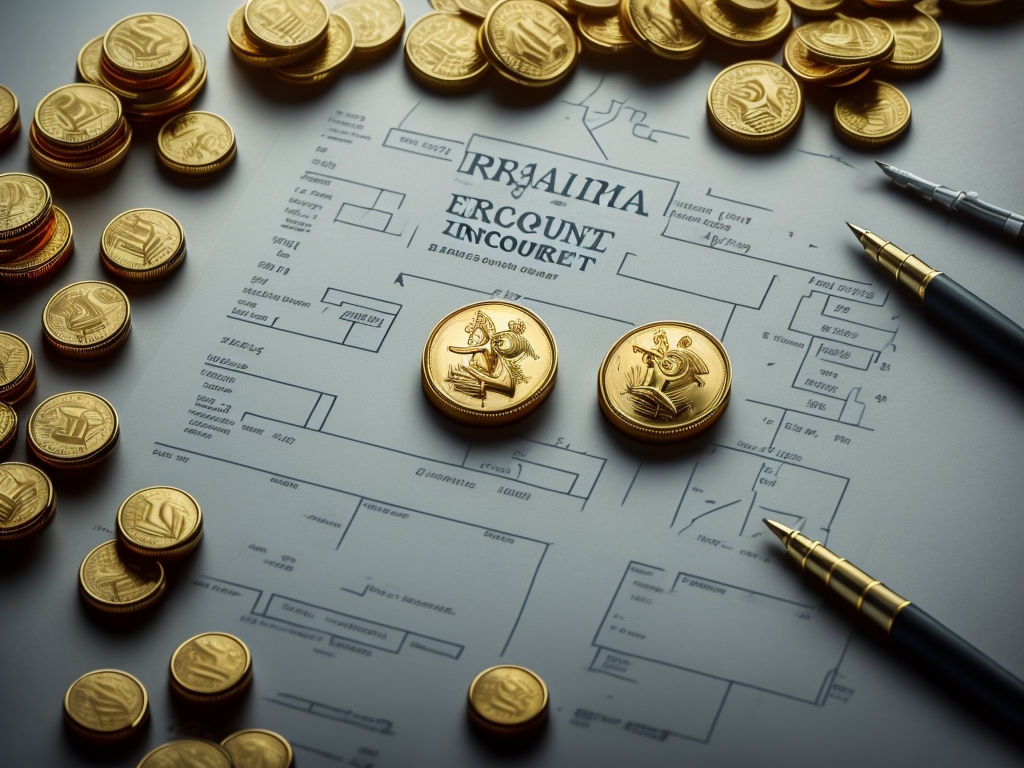Investing in gold through an IRA can be a smart move for those looking to diversify their retirement portfolio and hedge against market volatility. Gold has long been considered a safe-haven asset, providing stability and protection during economic downturns. By understanding the benefits and mechanics of a gold-backed IRA, you can take steps to secure your financial future with this valuable precious metal.
| Key Benefits of a Gold IRA |
Features |
| Diversification |
Reduces overall portfolio risk by adding a non-correlated asset |
| Inflation Hedge |
Gold has historically maintained its purchasing power during inflationary periods |
| Potential for Growth |
Gold prices can rise during times of economic uncertainty, providing upside potential |
| Tax-Deferred Savings |
Contributions and earnings grow tax-deferred until withdrawal in retirement |
What is a Gold IRA?
A gold IRA, or a self-directed individual retirement account (IRA), is a type of retirement savings plan that allows investors to hold physical gold, silver, platinum, and palladium as part of their retirement portfolio. Unlike a traditional IRA, which typically invests in stocks, bonds, and mutual funds, a gold IRA enables you to diversify your savings by including
precious metals as an asset class. This can provide a hedge against market fluctuations and offer the potential for long-term growth.
The Benefits of Investing in Gold Through an IRA
One of the primary advantages of investing in
gold through an IRA is the ability to leverage the tax-deferred or tax-free growth of your retirement savings. Contributions to a gold IRA, whether from a rollover or direct transfer, are made with pre-tax dollars, allowing your investments to grow without the immediate burden of taxes. This can lead to significant long-term wealth accumulation, as the compounding effect of tax-deferred growth can be substantial.
Diversification is another key benefit of holding
gold in an IRA. Gold has historically exhibited low correlation to traditional asset classes, such as stocks and bonds, making it an effective hedge against market volatility. By including
gold in your retirement portfolio, you can potentially reduce the overall risk and volatility of your investments, providing a measure of stability during economic downturns.
Furthermore,
gold is widely regarded as an inflation hedge. Throughout history, the
precious metal has maintained its purchasing power, often increasing in value during periods of high inflation. This can be particularly beneficial for retirees who are living on a fixed income and need to preserve the real value of their savings.
How Does Buying Gold for an IRA Work?
The process of
buying gold for an IRA typically involves the following steps:
1. Establish a self-directed IRA: You’ll need to open a self-directed IRA account with a custodian that specializes in
alternative assets like
precious metals. This custodian will handle the administrative and regulatory aspects of your
gold IRA investments.
2. Fund your IRA: You can fund your
gold IRA through a rollover or direct transfer from an existing retirement account, such as a 401(k) or traditional IRA. Alternatively, you can make new contributions to your
self-directed IRA to purchase
gold.
3. Select eligible
gold coins or bullion: The Internal Revenue Service (IRS) has specific guidelines on the types of
gold products that are eligible for inclusion in a
gold IRA. These typically include certain
gold coins and
gold bullion that meet fineness and purity requirements.
4. Arrange for storage: The
physical gold you purchase for your
IRA must be stored in an IRS-approved depository, which is typically a secure facility operated by your
gold IRA custodian.
5. Monitor and manage your investments: Regularly review your
gold IRA holdings and make adjustments as needed to align with your investment goals and risk tolerance.
Eligible Gold Coins and Bullion for a Gold IRA
The IRS has established specific guidelines for the types of
gold coins and bullion that are eligible for inclusion in a
gold-backed IRA. These include:
–
American Eagle gold coins
–
Canadian Maple Leaf gold coins
–
Austrian Philharmonic gold coins
–
Australian Kangaroo/Nugget gold coins
–
Certain gold bars and rounds that meet the required fineness and purity standards (typically 99.5% or higher)
It’s important to note that not all
gold products are eligible for a
gold IRA. Investors should work closely with their
gold IRA custodian to ensure they are purchasing
approved gold coins or bullion to avoid any compliance issues.
Choosing a Reputable Gold IRA Custodian
Selecting a reputable and experienced
gold IRA custodian is crucial to the success of your
precious metals investments. A good custodian will guide you through the
gold IRA setup process, handle the administrative tasks, and ensure your
gold holdings are stored securely.
When evaluating
gold IRA custodians, consider the following factors:
–
Reputation and track record: Look for a custodian with a long history of providing reliable
gold IRA services and a strong reputation in the industry.
–
Regulatory compliance: Ensure the custodian is registered with the appropriate regulatory bodies and adheres to all applicable laws and regulations.
–
Storage and security: Verify that the custodian uses
IRS-approved depositories for the storage of your
physical gold and has robust security measures in place.
–
Fees and cost transparency: Understand the custodian’s fee structure, including any setup, storage, or transaction fees, to ensure you’re getting a fair and competitive deal.
By choosing a reputable
gold IRA custodian, you can have confidence that your
precious metals investments are in good hands and are being managed in compliance with all relevant regulations.
Funding Your Gold IRA: Rollover vs. Direct Transfer
There are two primary ways to fund your
gold-backed IRA: through a rollover or a direct transfer.
Rollover: A rollover involves transferring funds from an existing retirement account, such as a 401(k) or traditional IRA, to your
self-directed gold IRA. This process allows you to move your retirement savings from one account to another without incurring any tax penalties, provided the rollover is completed within the allotted time frame.
Direct Transfer: A direct transfer is a transfer of funds directly from one retirement account to another, without the assets ever passing through your hands. This method is often preferred as it eliminates the risk of missing the 60-day rollover deadline and potentially incurring taxes or penalties.
Regardless of the funding method you choose, it’s essential to work closely with your
gold IRA custodian to ensure the process is handled correctly and in compliance with all relevant regulations.
Storage and Security Considerations
One of the key responsibilities of a
gold IRA custodian is the secure storage of your
physical gold holdings. The IRS requires that all
gold assets held in a
gold IRA be stored in an
IRS-approved depository, which is typically a secure facility operated by the custodian or a third-party storage provider.
These depositories employ
state-of-the-art security measures, including 24/7 surveillance, armed guards, and advanced access controls, to ensure the
safety and integrity of your
precious metals investments. Additionally, the
gold holdings are typically insured against theft, loss, or damage, providing an extra layer of protection for your retirement savings.
It’s important to note that you, as the
gold IRA account holder, do not have direct access to the
physical gold stored in the depository. All transactions and withdrawals must be coordinated through your
custodian, ensuring compliance with IRS regulations.
Tax Advantages of a Gold-Backed Retirement Account
One of the primary benefits of holding
gold in an IRA is the potential for tax-deferred or tax-free growth of your investments. Contributions to a
traditional gold IRA are made with pre-tax dollars, allowing your
gold holdings to grow without the immediate burden of taxes. This can lead to significant long-term wealth accumulation, as the compounding effect of tax-deferred growth can be substantial.
Alternatively, you may choose to invest in a
Roth gold IRA, which is funded with after-tax dollars. While you won’t receive an upfront tax deduction, any
qualified withdrawals you make in retirement will be tax-free, potentially providing even greater long-term benefits.
Additionally, the
sale or distribution of
gold from an IRA is generally taxed as ordinary income, rather than the potentially higher capital gains tax rate that would apply to
gold investments held outside of a retirement account.
Diversifying Your Portfolio with This Precious Metal
Investing in
gold through an IRA can be a valuable addition to your overall retirement portfolio.
Gold’s low correlation to traditional asset classes, such as stocks and bonds, makes it an effective diversification tool, helping to reduce the overall risk and volatility of your investments.
During periods of economic uncertainty or high inflation,
gold has historically maintained its purchasing power and even increased in value, providing a hedge against market downturns. This can be particularly beneficial for retirees who are living on a fixed income and need to preserve the real value of their savings.
By allocating a portion of your retirement savings to
physical gold held in a
self-directed IRA, you can potentially enhance the long-term stability and performance of your portfolio, while also enjoying the tax-deferred or tax-free growth of your
precious metals investments.
Monitoring and Managing Your Gold IRA Investments
Maintaining an active role in the management of your
gold IRA investments is crucial to ensuring the long-term success of your retirement savings. This involves regularly monitoring the performance of your
gold holdings, making adjustments to your asset allocation as needed, and staying informed about any regulatory changes or market developments that may impact your
precious metals investments.
Your
gold IRA custodian will provide you with periodic statements and reports detailing the value and composition of your
portfolio. It’s important to review these documents carefully and communicate with your custodian if you have any questions or concerns.
Additionally, you may want to consider working with a financial advisor who has expertise in
alternative assets and
precious metals investing to help you develop and implement a comprehensive investment strategy for your
gold IRA. This can ensure that your
gold holdings are aligned with your overall financial goals and risk tolerance.
Potential Drawbacks and Risks to Consider
While investing in
gold through an IRA can offer numerous benefits, it’s important to be aware of the potential drawbacks and risks associated with this type of investment:
Storage and Custody Fees: Holding
physical gold in an IRA requires the payment of storage and custody fees to the custodian and depository, which can eat into your investment returns over time.
Liquidity Constraints: Unlike stocks or mutual funds,
physical gold held in an IRA cannot be easily liquidated on demand. Withdrawals and distributions are subject to IRS regulations and may incur taxes and penalties if not handled properly.
Market Volatility: While
gold is often viewed as a safe-haven asset, its price can still be subject to market fluctuations and economic conditions, which may impact the overall performance of your
gold IRA investments.
Regulatory Changes: The IRS and other regulatory bodies may introduce new rules or restrictions related to
gold IRAs in the future, which could potentially impact the way you manage your
precious metals investments.
It’s essential to carefully weigh these potential drawbacks and risks against the benefits of
holding gold in an IRA and to consult with a financial advisor or tax professional to ensure that this investment strategy aligns with your overall retirement goals and risk tolerance.
Getting Started: The Gold IRA Setup Process
If you’re interested in adding
gold to your retirement portfolio through an IRA, the first step is to find a reputable
gold IRA custodian that can guide you through the setup process. Here’s a general overview of the steps involved:
1.
Open a Self-Directed IRA: Work with your custodian to establish a self-directed IRA account that will allow you to hold
physical gold and other alternative assets.
2.
Fund Your IRA: You can fund your
gold IRA through a rollover or direct transfer from an existing retirement account, or by making new contributions.
3.
Select Eligible Gold Coins or Bullion: Choose from the
IRS-approved list of
gold products that can be held in your
self-directed IRA.
4.
Arrange for Storage: Your
gold will be stored in an
IRS-approved depository operated by your custodian or a third-party provider.
5.
Monitor and Manage Your Investments: Regularly review your
gold IRA holdings and make adjustments as needed to align with your investment goals and risk tolerance.
By working closely with an experienced
gold IRA custodian, you can navigate the setup process with confidence and begin diversifying your retirement savings with this
valuable precious metal.
Conclusion
Investing in
gold through an IRA can be a smart move for those looking to enhance the long-term stability and growth potential of their retirement portfolio. By leveraging the tax-deferred or tax-free benefits of a
self-directed gold IRA, you can potentially protect your savings from market volatility and inflation while also enjoying the diversification benefits of
this precious metal.
Frequently Asked Questions
What is the minimum investment required for a gold IRA?
The minimum investment required for a
gold IRA can vary depending on the custodian, but it typically ranges from $5,000 to $25,000. Some custodians may have lower minimums, so it’s important to research and compare options to find the one that best fits your investment needs.
Can I hold both physical gold and gold ETFs in my gold IRA?
Yes, you can hold a combination of
physical gold and
gold ETFs (exchange-traded funds) in your
gold IRA. This can provide additional diversification and flexibility within your
precious metals investments. However, it’s important to ensure that any
gold ETFs you choose are IRS-approved for inclusion in a
self-directed IRA.
How do I withdraw or distribute my gold IRA assets?
Withdrawing or distributing
assets from a gold IRA is subject to IRS regulations and may have tax implications. It’s recommended to work closely with








